Felix Mendelssohn Bartholdy
Felix Mendelssohn Bartholdy ranks among the most pre-eminent, universally gifted and versatile musicians of the 19th century. His musical work as a composer, conductor and pianist took him all over Europe. For twelve years, Leipzig was the place where he lived and worked. As musical director of the Gewandhaus and co-founder of the first German conservatory, he had a decisive influence on the musical life and the musical charisma of the city.
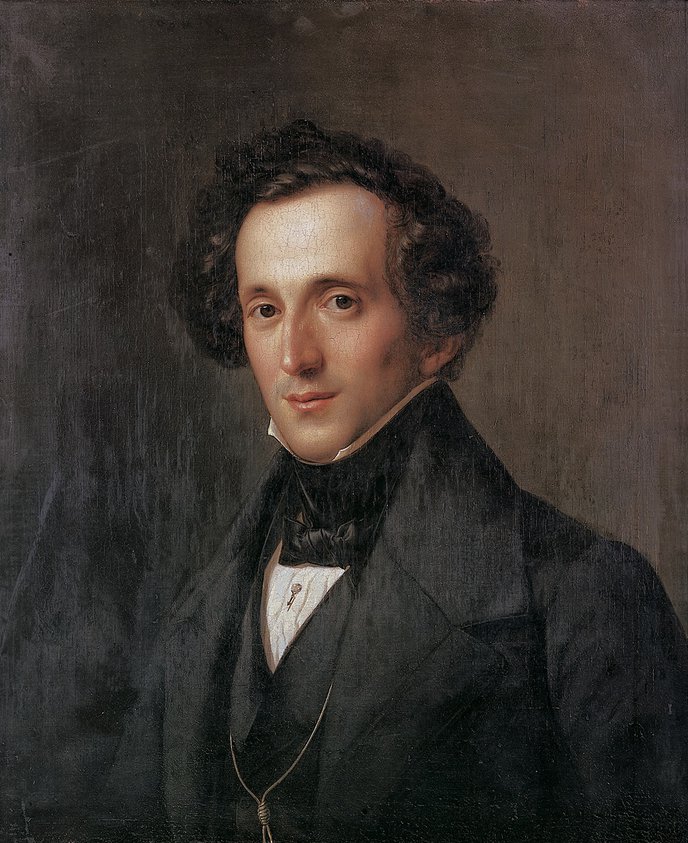
-
Child prodigy and educated citizen
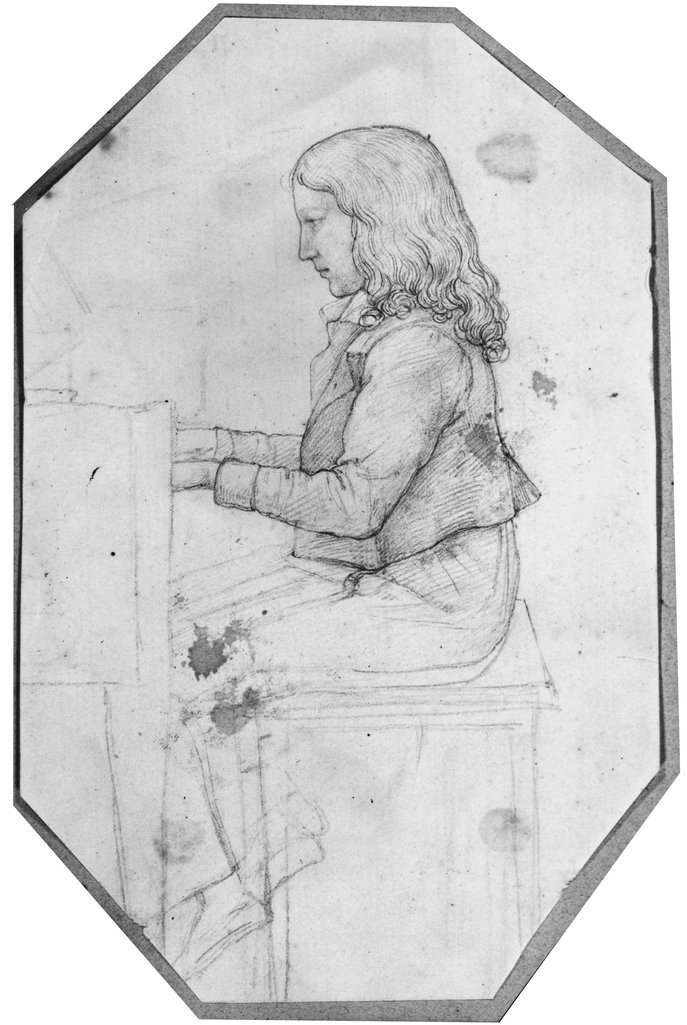
Wilhelm Hensel: Felix Mendelssohn Bartholdy, around 1820, Picture Archive Prussian Cultural Heritage (bpk) Felix Mendelssohn Bartholdy's musical talent was already evident from his earliest childhood. He performed in public as a pianist for the first time at the age of nine, received composition lessons at the age of ten, wrote his first symphony at the age of twelve, and at the age of seventeen composed the concert overture to A Midsummer Night's Dream, which is still well known and popular today. As a platform for the child prodigy, the parents established the Sonntagsmusiken Sunday concerts in their home, which developed into a popular meeting place for musicians and music connoisseurs. In addition to musical instruction, Felix and his siblings enjoyed a comprehensive humanistic education. Added to this was the unique intellectual atmosphere in the Mendelssohn home. As a centre for intellectually stimulating social intercourse, it was not only open to personal friends: representatives of the world of art and scholarship in Berlin met here to socialise and make music. Felix met Georg Wilhelm Friedrich Hegel, Alexander and Wilhelm von Humboldt, Heinrich Heine, Carl Maria von Weber, Louis Spohr and Niccolò Paganini, among others. Felix Mendelssohn Bartholdy amazed his contemporaries with his versatile abilities: his drawings and watercolours show his artistic talent, but the poems he occasionally wrote and the detailed letters from his travels also testify to a great linguistic talent.
-
Fanny and Felix
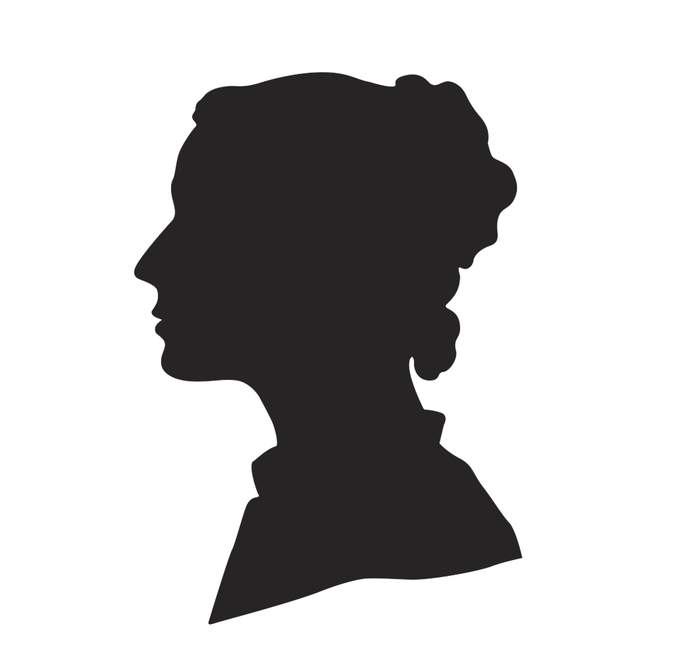
Silhouette of Fanny Hensel, Mendelssohn-Haus Leipzig There was a very special connection between Felix Mendelssohn Bartholdy and his sister Fanny Hensel. On the one hand, there was the great affection among the siblings, on the other hand, the great musical talent. Both received instrumental lessons from their earliest childhood, together attended composition lessons with Carl Friedrich Zelter, and performed at their parents' Sunday concerts. While the father granted his son a career as a musician, he restricted his daughter to her role as a housewife and mother who had to put her musical skills at the service of the family. While Felix caused a sensation throughout Europe, Fanny managed to turn her own Sunday concerts into a well-known musical institution within the confines of the conventions and made several public appearances as a pianist in Berlin. Fanny and Felix remained musically inspiring and critical partners for each other despite the physical distance. Felix was initially sceptical about Fanny's wish to publish her works after their father's death, but jokingly granted her his Blessing of the Craft after the publication of her Opus 1. To his great regret, Felix only understood at the end of her life how much the social corset ultimately wore on Fanny. In the six months that he survived her, he put works into print that she had intended for publication.
-
Bach and Goethe
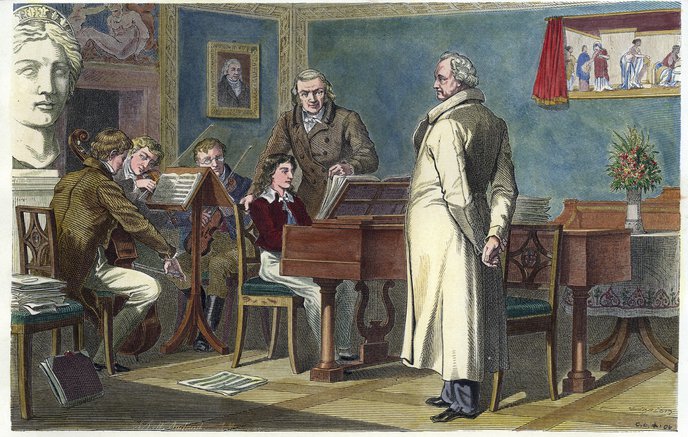
The 12-year-old Felix with Goethe, colored drawing from: Die Gartenlaube, 1867 The particular preference for the music of Johann Sebastian Bach was deeply rooted in the Mendelssohn Bartholdy family. It is therefore no coincidence that Carl Friedrich Zelter was employed to teach composition. Zelter directed the Berliner Singakademie choir, in which the entire Mendelssohn family sang, and in which Bach's music was part of the regular repertoire. At the age of twenty, Felix Mendelssohn Bartholdy performed the St Matthew Passion with the Berliner Singakademie for the first time after Bach's death with spectacular success, bringing back to memory the music of the cantor at St. Thomas Church in Leipzig, which had almost been forgotten by a wide audience. Mendelssohn had the first monument to Johann Sebastian Bach erected in Leipzig.
It was Carl Friedrich Zelter who introduced the 12-year-old Felix to Johann Wolfgang von Goethe in Weimar. With his nature and his piano playing, the child immediately won the affection of the then 72-year-old poet, whose verses inspired Mendelssohn to write many lieder and to compose the ballad The First Walpurgis Night, op. 60. Who knows what would have become of me without Weimar, without Goethe, Mendelssohn later confessed. Felix Mendelssohn Bartholdy visited Goethe a total of four times. In 1830, on the way to Italy, equipped with Goethe's Italian Journey, Felix Mendelssohn Bartholdy met the aged prince of poets for the last time.
-
England and Europe
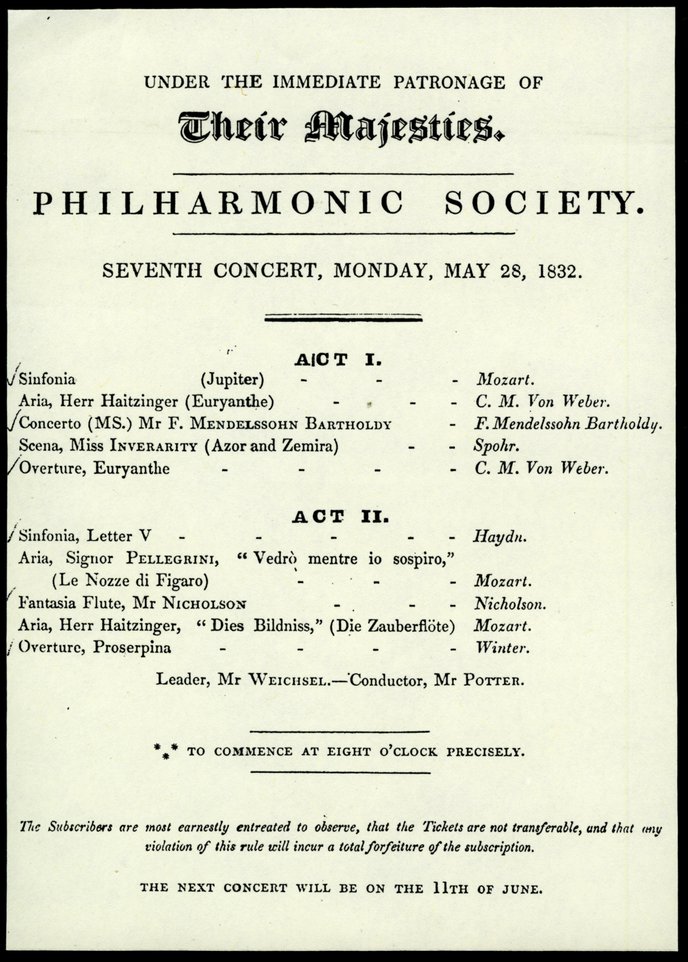
Program sheet for the Philharmonic Society concert, London 28th May 1832 Felix Mendelssohn Bartholdy realised a “European” way of life in an almost ideal way: as a composer, conductor, pianist, and chronicler who drew and wrote letters, he travelled not only to many German cities but also to the music and cultural metropolises of Central Europe from an early age.
The journey to Paris in 1825, accompanied by his father, pointed the way forward. 16-year-old Felix faced the opinion of Luigi Cherubini, an authority in the music world. His positive assessment encouraged Abraham Mendelssohn Bartholdy to support his son in his musical career. In 1829, he made it possible for him to embark on an almost three-year educational journey through England, Austria, Italy, Switzerland, and France.
Already during his first stay in London, Mendelssohn celebrated great triumphs as a conductor and pianist; nine more trips to England were to follow during the course of his life, which lasted only 38 years. He was not only inspired by the multifaceted musical life in London, but also became a role model and innovator himself, who enriched the English musical landscape with his performances - incidentally also as an organist - for example with the works of Bach and Beethoven. The British royal couple received the composer several times, and twice he was asked to direct the Birmingham Music Festival. As part of that festival, his oratorio Elijah had a spectacular premiere in 1847.
-
Musical director of the Gewandhaus
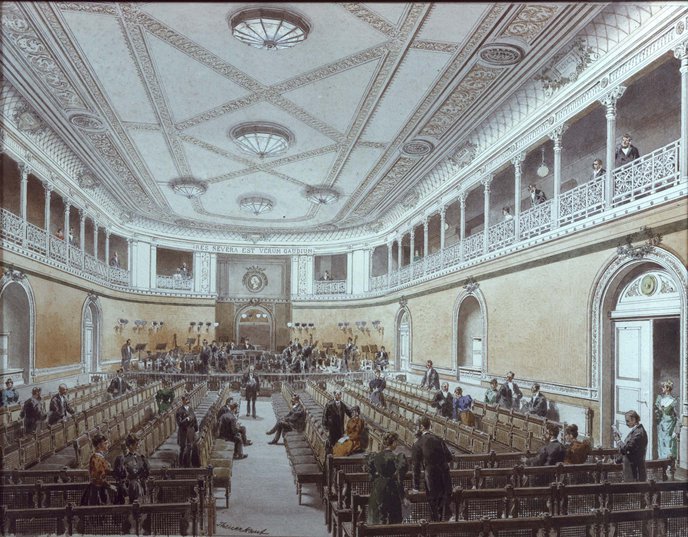
Gottlob Theuerkauf: Hall of the old Gewandhaus zu Leipzig, SGM inventory-Nr. 1781 Felix Mendelssohn Bartholdy held the position of musical director of the Gewandhaus for twelve years. When he came to Leipzig in 1835 to take up this position, he was just 26 years old.
With his work, he created the foundations for the modern concert practice in Leipzig.
Several innovations introduced by the exceptional young artist paved the way for this development. When he took up his position, he abolished the previously customary division of labour between concertmaster, who was responsible for conducting instrumental music, and musical director, who was solely responsible for vocal music. Mendelssohn insisted on rehearsing and performing all the concerts with the orchestra himself. This was not for reasons of vanity on the part of the new musical director, but because he strove to improve the musical standard. In addition, there was now a conductor at the stand who saw himself as an interpreter of the respective composer and transferred his view to the orchestra.
Under Mendelssohn's direction, it was also possible to redesign the programmes. He introduced a cycle of what he called Historical Concerts to arouse the interest of the audience in music-historical contexts. Nevertheless, Mendelssohn did not neglect the works of his contemporaries either. He promoted Robert Schumann, for example, but he also included compositions by Franz Liszt and Hector Berlioz in the concert programmes. He also succeeded in bringing renowned artists to Leipzig. All this led to a golden age of the Gewandhaus concerts that lasted for decades.
-
Genius and work
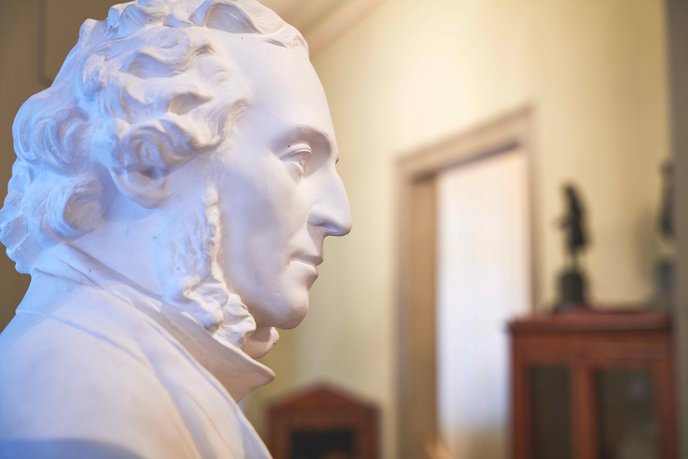
Mendelssohn bust after Ernst Rietschel © Christian Kern © Christian Kern By the time of his early death at the age of only 38, he had created an oeuvre of over 750 works. Felix Mendelssohn Bartholdy is known for his extensive and important work in many different genres from the great oratorios St. Paul and Elijah, the concert overtures to A Midsummer Night's Dream and The Hebrides, the symphonies, incidental music, concertos, and chamber music works, to the popular lieder with and without words.. During his lifetime he was considered the most respected and successful musician of his time - not only as a composer, but also as a conductor and virtuoso. But in post-revolutionary Germany, Mendelssohn's music increasingly lost its appeal. In 1850, Richard Wagner published Das Judenthum in der Musik (Judaism in Music) under a pseudonym, in which he denied Jewish musicians, but especially the baptised Felix Mendelssohn Bartholdy, the ability to compose music that really touched the heart because of his Jewish origins. His music was even banned during National Socialism, which fostered an attitude towards the work of Felix Mendelssohn Bartholdy that persisted well into the 20th century.
Today, the music of Felix Mendelssohn Bartholdy has returned to the great stages of the world.
-
Biography (chronology)
Felix Mendelssohn Bartholdy 1809–1847
1809- Born in Hamburg on 3 February (his mother is Lea, née Salomon, his father is Abraham, son of the Jewish philosopher Moses Mendelssohn)
1811
- The family moves to Berlin
1816
- On 21 March, Christian baptism of all four children of the family (Fanny is ten, Felix seven, Rebecka almost five and Paul three years old)
- Piano lessons together with Fanny with Ludwig Berger, violin lessons with Wilhelm Henning
1818
- First public performance as a pianist
1819
- Music theory lessons together with Fanny with Carl Friedrich Zelter
1820
- Beginning of the first composition album
- Drawing lessons with Johann Gottlob Samuel Rösel
- On 1 October, together with Fanny, he joined the Berliner Singakademie choir
1821
- In November, first visit with Zelter to Goethe in Weimar, before that a first short stay in Leipzig
1822
- Beginning of the Sunday concerts in the parental home
1825
- Career-defining trip to Paris together with his father to see Cherubini
1827
- Enrolment at the University of Berlin, among others lectures on aesthetics with Hegel
1829
- On 11 March, first revival performance of Bach's St. Matthew Passion in the Berliner Singakademie under Mendelssohn's direction
- On 10 April, start of an eight-month educational trip to England and Scotland
- Concerts in England
1830
- On 13 May, start of the Grand Tour to Italy (itinerary: Leipzig, Weimar - last encounter with Goethe -, Munich, Vienna, Venice, Florence, Rome, Pompeii, Naples)
1831
- Start of the return journey via Rome, Switzerland, Munich, Frankfurt / Main, Düsseldorf, Liège, Paris, London
1832
- Return to Berlin in June
1833
- Rejection of the application to succeed Zelter as director of the Berliner Singakademie
- Direction of the Lower Rhenish Music Festival in Düsseldorf
- From 1 October engagement as municipal musical director in Düsseldorf
1835
- On 4 October, inaugural concert of the 26-year-old Felix Mendelssohn Bartholdy at the Gewandhaus (including the “Calm Sea and Prosperous Voyage” overture and Beethoven's 4th Symphony); move into “Reichel's garden” at Mme Pensa’s
- On 9 November, Bach's Concerto for three pianos and orchestra in D minor in the Gewandhaus for the first time (piano: Clara Wieck, Louis Rakemann, and Felix Mendelssohn Bartholdy)
- On 19 November, death of his father in Berlin
1836
- Director of the Lower Rhenish Music Festival in Düsseldorf, world premiere of the “St. Paul” oratorio on 22 May
- Honorary doctorate from the Faculty of Philosophy at the University of Leipzig
- “St. Paul” Oratorio completed
- On 7 November, Leipzig premiere of Handel's “Israel in Egypt” oratorio in the Paulinerkirche church (conductor: Mendelssohn)
1837
- Marriage to Cécile Jeanrenaud, daughter of a Huguenot clergyman, in Frankfurt / Main
- Move into a spacious flat in “Lurgenstein’s garden” (Leipzig)
- Direction of concerts at the Music Festival in Birmingham
1838
- On 1 January, premiere of the 42nd Psalm “Wie der Hirsch schreit” (As pants the hart)
- Birth of the first son, Carl
- On 15 February, first of what he called “Historical Concerts” in the Gewandhaus (all four conducted by Mendelssohn)
1839
- On 21 March, world premiere of Schubert's Great Symphony in C major at the Gewandhaus (conductor: Mendelssohn)
- Birth of daughter Marie
1840
- On the occasion of the 400th anniversary of the invention of the printing press, world premiere of the 2nd symphony “Lobgesang” (Hymn of Praise) in St. Thomas Church
- Efforts on the part of Mendelssohn for the purposes of improving the situation of his musicians
- Recognition of the Gewandhaus Orchestra as a city orchestra
- On 6 August, Mendelssohn's organ concert in St. Thomas Church for the benefit of a Bach monument
1841
- On 31 March, world premiere of Schumann's “Spring Symphony” at the Gewandhaus (conductor: Mendelssohn)
- On 4 April, the first Leipzig revival performance of Bach's St. Matthew Passion in St. Thomas Church
- Birth of son Paul
- On 1 July, appointment as royal Saxon musical director
- In the summer, move to Berlin as Friedrich Wilhelm IV's “in-house composer”, but repeatedly a guest conductor at the Gewandhaus until his final return in 1845
- On 13 October, appointment as royal Prussian musical director
1842
- On 3 March, world premiere of the “Scottish Symphony” at the Gewandhaus, conducted by the composer
- Reception by Queen Victoria on his seventh trip to England
- On 12 December, death of his mother in Berlin
1843
- On 2 April, opening of the first German conservatory in Leipzig (1st director of studies: Mendelssohn)
- Honorary citizenship of the city of Leipzig
- On 23 April, unveiling of the Bach monument donated by Mendelssohn
- Birth of son Felix
1844
- Resignation from all positions in Berlin
1845
- On 13 March, premiere of Mendelssohn's Violin Concerto in E minor in Leipzig (conductor: Niels W. Gade, soloist: Ferdinand David)
- On August 13, return to Leipzig, move of the Mendelssohn family into Königstrasse 3 (today: Goldschmidtstrasse 12)
- Birth of daughter Elizabeth
- From the 1845/46 season, direction of the Gewandhaus concerts together with Gade
1846
- Oratorio “Elijah” finished in July
- On 26 August, premiere of the “Elija” oratorio in Birmingham, conducted by the composer
- On 19 July, Mendelssohn’s last performance as pianist at the Gewandhaus
1847
- On 18 March, last Gewandhaus concert under the direction of Mendelssohn
- (On 19 March, resignation from the position of musical director of the Gewandhaus)
- On 14 May, death of his sister Fanny in Berlin
- On 4 November, death of Mendelssohn in Leipzig
- On 7 November, funeral service in Leipzig
- On 8 November, burial in Berlin, Dreifaltigkeitsfriedhof cemetery
-
Mendelssohn catalogue of works
The comprehensive catalogue of the composer's works was published on the occasion of the 200th birthday of Felix Mendelssohn Bartholdy.
Ralf Wehner's Mendelssohn-Werkverzeichnis (MWV) catalogue of works was presented at Mendelssohn House in Leipzig on 26 August 2009 as part of the international “Felix Mendelssohn Bartholdy - Kompositorisches Werk und künstlerisches Wirken” (Compositional Work and Artistic Activities) congress and the Mendelssohn Festival Days that year.
Dr. Ralf Wehner is project director of the Leipzig Mendelssohn Complete Edition at the Saxon Academy of Sciences and Humanities.Until today, we could only guess at the extent of Mendelssohn's oeuvre. The traditionally known works bear opus numbers (authentic up to op. 72, assigned by posterity up to op. 121). However, most of the approximately 750 compositions were still unpublished in the 1960s. Since then, musical practice has gratefully accepted the publication of numerous early works as part of the Complete Edition.
A comprehensive overview of his work, however, has been a long time coming. In the Mendelssohn Year 2009, this gap was closed in the context of the Complete Edition. The MWV catalogues the composer's oeuvre in 26 groups of works. In addition, descriptions of all known omnibus manuscripts and prints have been included. The appendix contains information on works of doubtful authenticity and on Mendelssohn's arrangements and editions of other works.
Wehner's work is based on years of research, during which material and information from more than 1,500 libraries worldwide, approximately 15,000 auction catalogues, and approximately 12,000 correspondence documents could be evaluated. 2,500 sources are listed for unknown works and different versions of works alone. Thus, the catalogue will be a treasure trove for scholars, musicians and music connoisseurs. The way the composer is perceived will change permanently as a result of the MWV.
The Mendelssohn monument in Leipzig
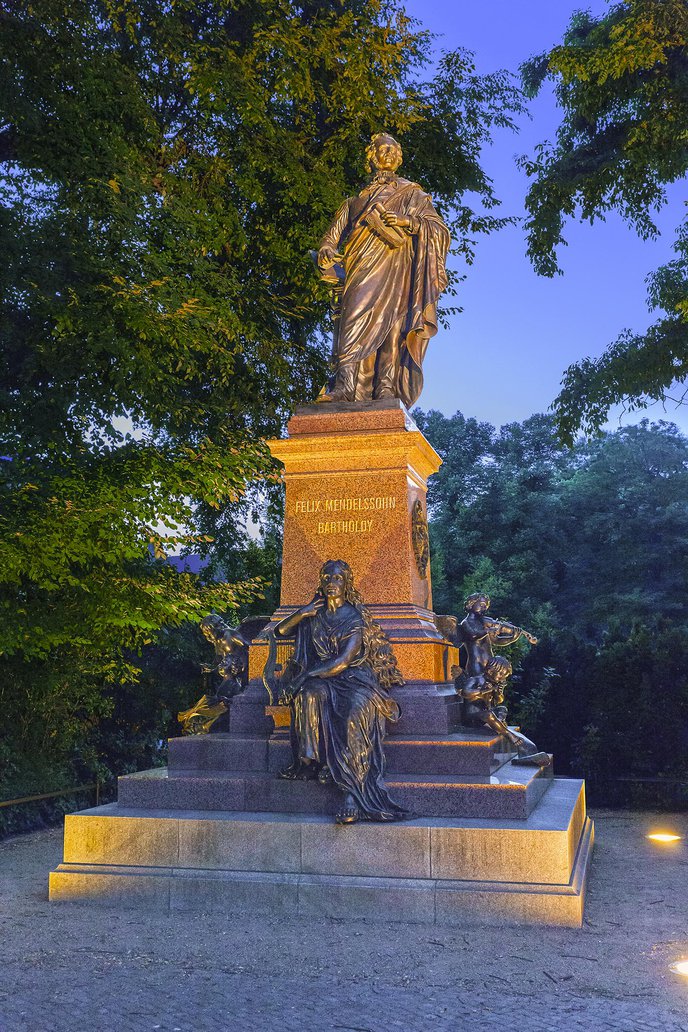
On 26 May 1892, 24 years after the establishment of a committee for a monument honouring composer Felix Mendelssohn Bartholdy and 45 years after his death, a bronze statue designed by Werner Stein was dedicated on the east side of the old Gewandhaus in Leipzig's music district. The monument's statement and historical and cultural importance were characteristic of the great sculptural art at the close of the 19th century and paid tribute to the brilliant musician Mendelssohn Bartholdy and his contribution to the city’s musical life. The Mendelssohn monument was torn down on 9 November 1936, during the National Socialist era, because Mendelssohn Bartholdy was considered a Jew and - according to NSDAP mayor Haake - “as such could not be presented as an exponent of a German city of music”. The whereabouts of the original monument are unknown.
Based on a 2003 agreement between then-Lord Mayor Wolfgang Tiefensee and the Gewandhaus Orchestra's Honorary Conductor, Kurt Masur, the decision was made to erect another Mendelssohn monument. With a generous contribution from a patron, Dr. Wolfgang Jentzsch, plans for the reinstallation of the monument began. The new location of the reconstructed Mendelssohn monument is at the heart of the city on Dittrichring, across from St. Thomas's Church. The monument was dedicated on 18 October 2008.
A four-metre-high bronze statue of Felix Mendelssohn Bartholdy stands on a four-meter-high granite plinth. The muse of music sits on the steps of the monument, and four cherubs – two playing instruments and two singing – are grouped on the sides. The front of the plinth bears the name “Felix Mendelssohn Bartholdy”, and on the back is the inscription “Edles nur künde die Sprache der Töne” (The language of music shall proclaim only what is noble). On the sides are medallions symbolizing sacred and secular music.
First and early editions of the works of Felix Mendelssohn Bartholdy
Enclosed the correction of my trio. But I must ask you to send me a proof for checking before you have it printed, so that it appears really correct. Felix Mendelssohn Bartholdy to Breitkopf & Härtel about his Opus 49
Of his more than 750 compositions, the extremely self-critical Felix Mendelssohn Bartholdy published only 72 with an opus number and 30 without. After the first performance, he usually subjected his works to a thorough revision before publication, which at times even lead to them not being published during his lifetime. One such work is the famous Italian Symphony, which did not appear in the first complete version until 1851, which Felix Mendelssohn Bartholdy rejected, however. It now belongs to the standard repertoire of every orchestra. His equally frequently performed Reformation Symphony was another work Mendelssohn could not stand at all anymore; he wanted to burn it and, above all, it was never to be published. Like many other works, it was published still during the 19th century. Mendelssohn House owns an extensive collection of first and early editions. The copies that have been digitised so far can be viewed in the digital library.